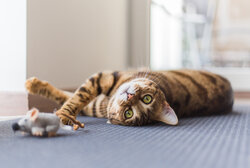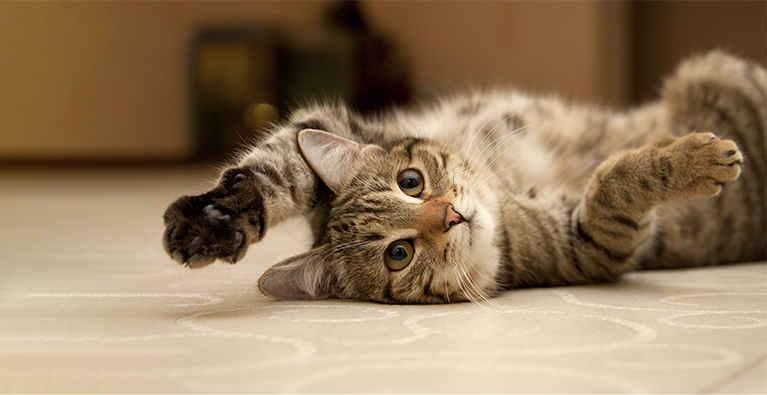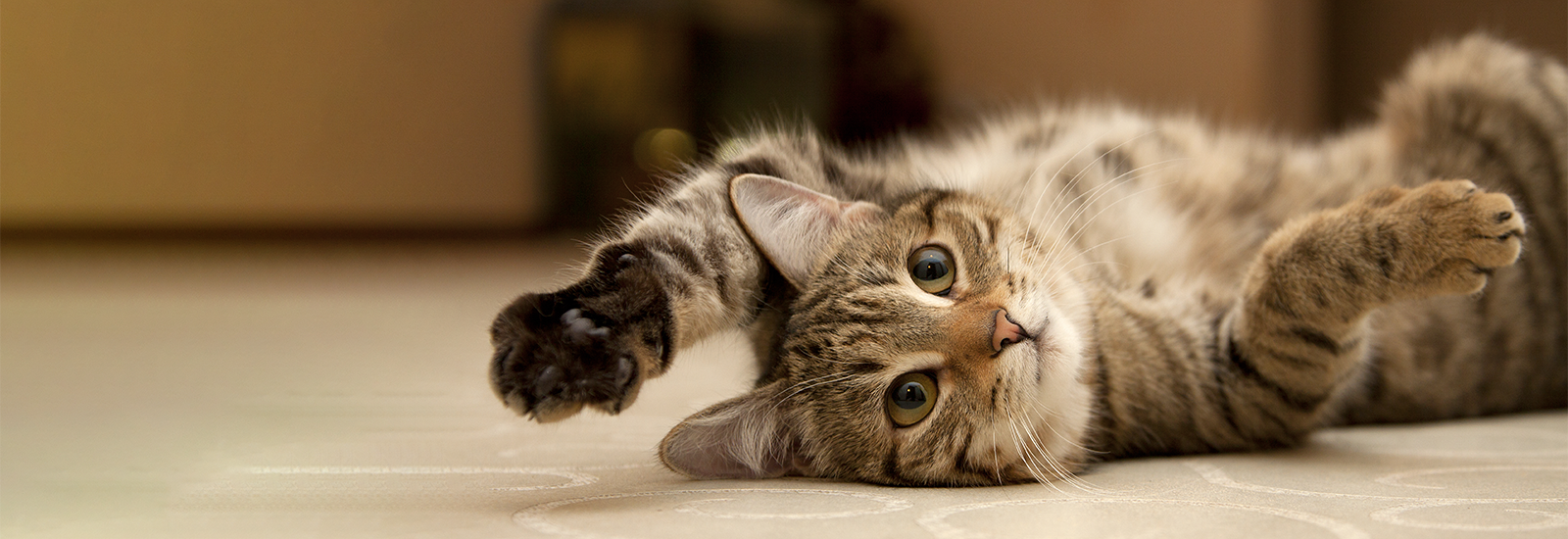How to get your cat to stop scratching
Scratch marks on wallpaper, sofas and carpets do not go down well with cat owners. We will help you identify the cause of this behaviour and provide you with tips on how to prevent unwanted scratching.
Scratching is part of a cat’s natural behaviour
You can control a cat’s scratching quite effectively, but you cannot completely stop or forbid a cat from scratching, because this behaviour is firmly embedded in every cat and has a number of functions:
- Sharpening the claws
Just like our fingernails, a cat’s claws continue to grow throughout its life. However, a claw differs from our nails with regard to its structure: it consists of an inner and an outer horny layer. Only the inner one grows back, whereas the outer layer has to be shed at regular intervals. A cat does this by scratching. If you look carefully, you can find the empty claw sheaths near the scratching utensils.
- Marking out territory
Whether indoors or outdoors – a cat’s instinct tells it that it has to mark its territory so that other cats will recognise this and respect it accordingly. This works in two ways: firstly, other cats should be made aware, even from a distance, of the presence of a territorial boundary by means of scratch marks. Outdoors, trees are usually used for this purpose, with their bark showing evidence of scratching. In addition, when a cat scratches, it spreads traces of its scent, which are released through glands on its paws. In this way, the territorial boundaries can be easily recognised even in the dark.
Why does my cat scratch the furniture, wallpaper and other objects?
Unfortunately for some cat owners, their pets are not particularly choosy when it comes to deciding where to scratch. They sharpen their claws on wallpaper, cupboards, sofas, table legs and carpets. There are a number of possible reasons for this:
- A lack of suitable scratching utensils
Cats want to sharpen their claws every day. However, if there they have no or not enough opportunities to do this, they will be forced to use the furniture. If you find scratch marks, you should therefore consider whether you have provided your cat with sufficient scratching options. First and foremost, a large scratching tree can be recommended. You can also buy scratching boards, scratching pads and scratching barrels. Do not hesitate to provide several, if necessary, in every room or close to every place that has ever been used for unwelcome claw sharpening.
- The wrong spot
On the one hand, scratching is all about the cat sharpening its claws, but on the other hand it also wants to mark its territory. If, for example, there is only one opportunity for scratching in a room that the cat is not particularly fond of, then it may show little interest. It is therefore important to provide scratching facilities in places that the cat likes to visit.
- The cat does not have enough to do
Is your cat often alone at home, does it not have another cat to play with and do you often have too little time to spend with your pet? If this is the case, it will look for an outlet for its feelings of frustration and boredom and will start redecorating your home in its own special way. You should therefore ask yourself whether the reason for the scratch marks in your home could be a lack of attention and variety in your cat’s everyday life. If this is the case, consider getting a second cat, provide different toys every day, extend your cat’s territory by cat-proofing your balcony and schedule enough time for playing and cuddling with your four-legged friend every day.
- The cat has not been neutered
As already mentioned, a cat also scratches in order to mark its territory. This is especially important for them when they have not been neutered. Having your cat neutered could therefore solve the problem of scratching and marking.
What should I do if I catch my cat scratching?
You must not shout at, hit, or shoo away your cat. But equally, you should not simply ignore the situation without protest, even if it is an old sofa that is about to be replaced. Cats are unable to distinguish on which piece of furniture they are allowed or forbidden to scratch. You can either tolerate occasional scratching or you can intervene consistently. For example, clap your hands and say “No!” firmly and clearly. Either give your cat another chance or pick it up straight away and put it on one of its scratching utensils. If your pet continues its scratching there, praise it and give it a treat.
Although cats may take a little longer than a dog to understand what is wanted of them, they are perfectly capable of understanding the association with a reward. If they get a treat for sharpening their claws on the scratching tree, most of them will be more than happy to focus on this and not the sofa.
When kittens scratch
Kittens learn to use their claws at an early age. This is not too much of a problem among cats; after all they all have protective coats. However, if their playmate happens to be one of our hands, this can become increasingly unpleasant as the cat grows older. In order to avoid having, for example, an 8-kilogram Maine Coon climbing up your body one day, it is better to show your cat right from the beginning that scratching you or your furniture will not be tolerated.
It is best to only use your hand for stroking and not for play. There are plenty of toys available that will provide relief for your forearms. If you do get scratched, do not ignore it, but make your displeasure clear to the cat with an “Ow!” or “Ouch!” and by temporarily stopping play. Your pet will certainly find this a shame and will try to learn from the situation. It is no different among young kittens. If one sibling gets too rough, the other one will retreat and the fun is over. Next time, they will therefore be more careful.
Summary
If you want to be on the safe side, make it clear to your kitten right from the start that scratching your hands or furniture is unwanted. If you are not planning to use your cat for breeding, it is best to have it neutered. Marking out its territory will then only be of minimal importance. It is crucial to provide your cat with enough scratching utensils in your home and to ensure that there is plenty of variety in your pet’s day-to-day life. The more a cat is occupied and content, the less it is likely to get any silly ideas.
You may also like this

Keeping cats occupied
Useful ideas for keeping cats occupied

Territorial behavior
Territorial behavior of outdoor and indoor cats

Neutring for cats
Neutring has many advantages

Training kittens
How to train kittens

